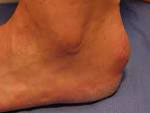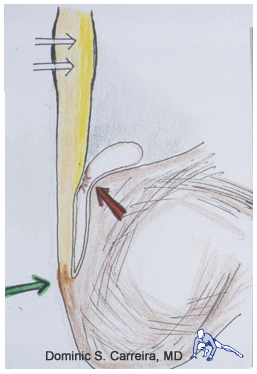The Achilles tendon can withstand forces of 1,000 pounds or more. A common overuse injury, Achilles pain typically occurs immediately at the tendon, which most patients can feel just underneath the skin at the back of the ankle. Over time and especially in very active and/or overweight individuals, the tendon can become degenerated (tendinosis) and inflamed (tendonitis). The tendon oftentimes becomes enlarged and thickened and may cause shoe irritation as it rubs. Not only do professional athletes and weekend warriors have pain, but also active individuals can suffer.
Office Appointments and Telemedicine with Dr. Carreira

You can also book an office appointment or a telemedicine visit by calling Dr. Carreira’s office at 404-355-0743. Book now.
Recurrent stresses on the tendon where it attaches (the insertion) or slightly higher up the leg (non-insertion) lead to degeneration, inflammation, microscopic tearing of the tendon, swelling and pain. Partial tears oftentimes occur in the setting of long standing degeneration.
There also may be associated swelling in the space between the tendon and the calcaneus, called the retrocalcaneal bursa. Thickening of the tendon may result from bone spurs on the back of the calcaneus which develop within the substance of the tendon.
A comprehensive treatment plan is implemented for this problem. All of these are designed to decrease the inflammation on the tendon. In cases where non-operative treatment has failed, surgery may be indicated, which may include the removal of excess bone, repair of the Achilles tendon itself, removal of bursitis, and possible augmentation of the repair with a transferred tendon called the FHL. Depending on the extent of tendon involvement, a minimally invasive approach or the traditional open incision may be used.
Dr. Carreira has prepared a document that offers some insight into the treatment of Achilles tendon injuries:
Download Treatment of Achilles Tendon Injuries » (PDF: 347KB)
Presenting to the American Orthopedic Foot and Ankle Surgeons
In July 2018 and March 2019, Dr. Dominic Carreira presented the Achilles insertional reconstruction technique to approximately 50 orthopedic foot and ankle surgeons at the annual meeting of the American Orthopedic Foot and Ankle Society (AOFAS) in Boston and at the Annual Meeting of the American Academy of Orthopedic Surgeons in Las Vegas. This layered technique of reconstruction is reliable and reproducible and has minimal potential complications.
As an orthopedic surgeon, Dr. Carreira regularly presents at educational seminars and annual meetings of medical and surgical societies. Additionally, he actively contributes to medical research, and publishes articles in leading medical journal, adding to the body of medical knowledge. Dr. Carreira’s full CV is available for review.
Achilles and Retrocalcaneal Bursa Surgery: General Facts of Recovery for Open Surgery
- The surgery is performed as an outpatient procedure
- An approximately 1-3 inch incision is made on the back of the heel
- Following surgery, crutches for two weeks
- At the first office visit, you will be able to start walking in a removable walking boot that has wedges in it
- The boot is worn for 6 weeks, and then the weaning process into a shoe is begun.
- The shoe may be an open back if the incision extends down to the level of the heel counter on the shoe
- Physical therapy is an important part of your recovery, starting typically at 6 weeks.
- You can expect swelling and tenderness at the back of the heel for about 4 to 6 months after surgery.
Post Operative Course:
Day 1
- Foot wrapped in bulky bandage
- Ice and elevate the foot
- Take pain medication
- Expect numbness in foot for 12- 24 hours
- Bloody drainage through bandage expected
- Do not change the bandages but you can add to the bandages if needed
Days 3-5
- First office visit
- Bandages replaced
- Placed in the CAM boot with wedges
- Partial weight bearing: ALWAYS IN THE BOOT
- Prescription given which details the wedge removals from the boot
Weeks 2-3
- Sutures may be removed
- Weight bearing in the boot as tolerated
Week 6
- The boot is gradually weaned to a sneaker-like shoe
- Stretching exercises are begun
Week 12
- Strengthening exercises may be initiated
- Gradual return to full activity including sports
Photos of Achilles Pain




